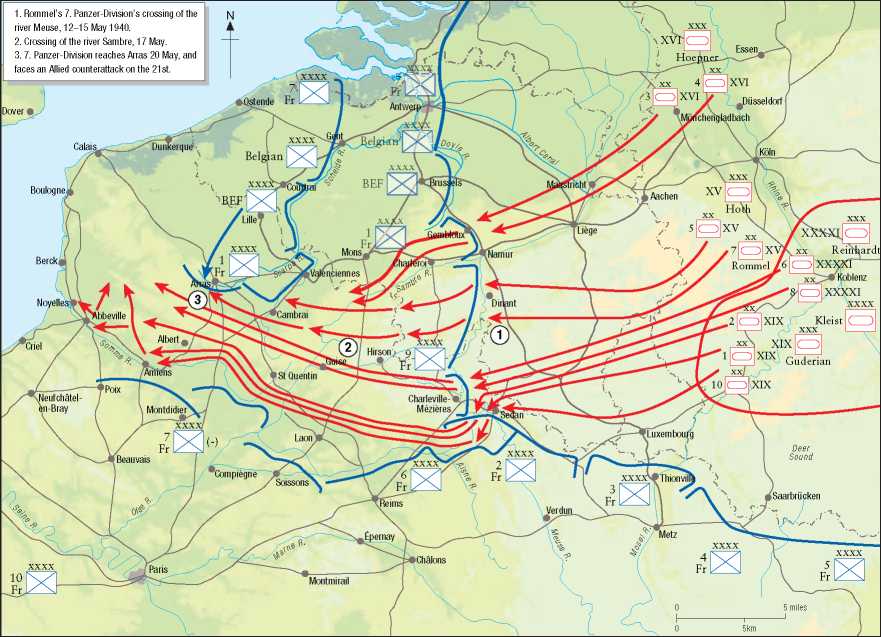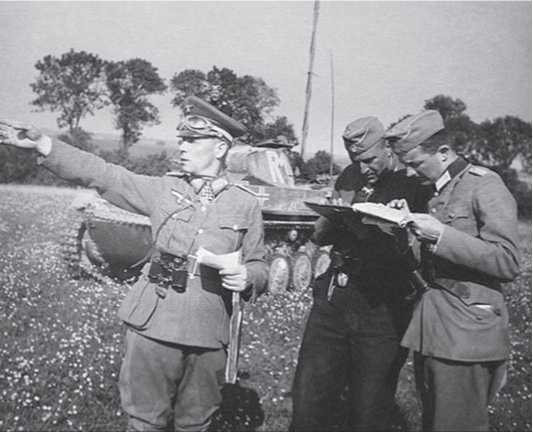
Once across the Meuse, Oberst von Bismarck, commander of Schutzen-Regiment 7, put himself at the lead of the advanced elements of his unit and probed towards the town of Onhaye, some 5km (3 miles) from the southern bridgehead. At 8.00am a message was received from his unit before communications broke down: Bismarck was surrounded at Onhaye. Without hesitation Rommel took all the available Panzers and advanced towards Onhaye with the aim of placing the Panzer Regiment itself in a
Wood 1,000 yards north of Onhaye and then to bring all other units up to that point, from where they could be employed to the north, north-west or west, according to how the situation developed' (The Rommel Papers, p. 12).
Approaching the southern edge of Onhaye, Rommel came under enemy fire with his tank being hit twice; a strike on the periscope wounded Rommel in the right cheek, nothing serious but it bled a great deal. 'The driver
Promptly opened the throttle wide and drove straight into the nearest
Bushes. He had gone only a few yards, however, when the tank slid down a steep slope on the western edge of the wood and finally stopped, canted over on its side, in such a position that the enemy, whose guns were in position about 500 yards away on the edge of the next wood, could not fail to see' (The Rommel Papers, p. 12). Apart from the tank, there was not much change from his experiences on Mount Cosna or the Kolovrat Ridge. Once again Rommel
Survived his clash with the enemy and, after fierce fighting, his units seized Onhaye to discover that Bismarck's message had been misunderstood and his unit had not been surrounded (eingeschlossen), but had simply reached (eingetroffen) Onhaye. By late evening, 7. Panzer-Division's spearheads had broken through the French second line of defence, driving a 12km-deep (7-mile) wedge into it, while a second bridge on the Meuse was completed. Rommel had broken through the enemy front in a similar manner to the way he had in 1917. There was, however, an important difference: even Rommel realized he could not be everywhere and thus had to rely on modern communications. These would play a key role in his new position as a divisional field commander and, again, were used in a decisive, speedy and flexible way. To avoid time-consuming coding and decoding, Rommel used the simple and ingenious system based on the Stosslinie (thrust line) - a line drawn on the map to which all units referred using a simple code. That made communications in the clear possible, all kept short and simple in the true spirit of Aufiragstaktik. An example would be Rommel's request for a situation report sent at 5.50am on 13 May, a simple 'Wie Lage?' (how's the situation?), which was answered with: '0600 S[chutzen] R[egiment] 7 Fluss Maas uberschritten' (river crossed at 6.00am). On 14 May Rommel's order to advance was again a simple 'Rommel 1930 Verfolgung mit allem Waffen', 'Rommel at 7.30pm: pursuit with all weapons'. Rommel himself stressed the role played by radio communications in ensuring tight control of his
Division, while all the time he led from the front.
A tight control west of the Meuse, and flexibility to meet the changing
Situation, were only made possible by the fact that the divisional commander with his signal troop kept on the move and was able to give his orders direct to the regiment commanders in the forward line. Wireless alone - due to the necessity for encoding - would have taken far too long, first to get the situation reports back to Division and then for Division to issue its orders. Continuous wireless contact was maintained with the division's operation staff, which remained in the rear, and a detailed exchange of views took place early each morning and each afternoon between the divisional commander and his la [staff officer, operations]. This method of command proved extremely effective. The Rommel Papers, p. 13
This was in fact the method used throughout the German Army, and
Especially by the Panzer divisions. Rommel was a more ardent exponent than most, mainly owing to his pronounced desire to lead from the front. In fact, his command skills during the campaign in the West, especially for an inexperienced infantry commander, compare very well with the more renowned and esteemed 'Panzer General' Guderian, who delayed his crossing of the Meuse at Sedan by waiting until a pontoon bridge was built before moving his tanks across the river, while Rommel moved his tanks across by ferry until his pontoon bridge became available, which enabled him to break through the French defences. Rommel's first test as a divisional commander, and a Panzer commander, was passed with flying colours.

However, he also showed his lack of interest in cooperating with other commanders, and thinking and acting 'within the framework of a general plan'. During the crucial hours of the Meuse crossing, there was equipment available for only one heavy pontoon bridge. Rommel asked and eventually obtained from the corps commander, General Hoth, that it was put at his disposal, much to the displeasure of General von Hartlieb of 5. Panzer-Division. To add insult to injury, 5. Panzer-Division's heavy tanks crossed the river by use
Rommel was awarded the Knight's Cross on 27 May 1940, and on 5 June his 7. Panzer-Division started its drive across France as part of the German offensive that ended with the French surrender. In the background is a PzKpfw II light tank from regimental HQ. (HITM)
Of Rommel's bridge, and he took the chance to put them under his
Command without asking permission. It was at this stage that Rommel and the commander of 5. Panzer-Division's Panzer-Regiment 15, Oberst Johannes Streich had a major argument that led to mutual antipathy.
Although it is true that the neighbouring 5. Panzer-Division was slower than Rommel's own 7. Panzer-Division, and Hartlieb was relieved of command on 21 May and given an administrative role, Hartlieb was also correct in his complaints to Hoth that 7. Panzer-Division could not always fight alone, and should operate more as part of the corps. Hoth may not have been particularly happy with Rommel's methods of command but, realizing that he did not have enough tanks available to support two breakthroughs, was left with no other choice but to support him.
One other point about this campaign that is worth mentioning is the feeble nature of the opposition. The French were unable to organize a timely counterattack, and therefore Rommel's 7. Panzer-Division was able to regroup on the morning of 15 May and set out from its forward positions, now some 10km (6 Miles) west of Onhaye. To the north the French 1ere Division blindee was regrouping and preparing a counterattack following a long march. Had this unit launched its attack the previous evening it would have stormed the positions of the unprepared leading elements of 7. Panzer-Division. However, the heavy French tanks were not designed for travelling long
Distances and they were compelled to wait for the arrival of tank transporters. On the morning of 15 May they had started the long and complicated process of refuelling when Rommel's 7. Panzer-Division attacked them.
Rommel's advance cut the French supply route and the division itself was actually destroyed by the neighbouring 5. Panzer-Division. At times, this is what makes the difference between a bold action and a gamble: a feeble enemy. This is precisely what Rommel faced again on 21 May at Arras, when his division alone faced the British and French counterattack; the
Neighbouring 5. Panzer-Division was delayed, and his own 7. Panzer-Division was dispersed over some 25km (16 miles) with the armour leading and the infantry following up behind. When the British Matilda tanks, invulnerable to any German anti-tank weapon, advanced upon the German infantry they came close to collapse and disaster was avoided only by the faulty British command system, which meant there was no senior commander at the front, combined with Rommel's presence in the front lines. His presence stiffened the resolve of his troops and they were able to hold the line. The German defences were broken through twice, but there was no panic. Rommel was able to set up a new forward defence line with light anti-tank and anti-aircraft guns. Although these were unable to harm the Matildas, they halted the accompanying light tanks. At the same time, a main defence line was arranged with artillery and heavy anti-aircraft guns, the famous 88mm, which
Destroyed some 20 tanks in a few minutes. The intervention of the Luftwaffe and the recall of 7. Panzer-Divisions' Panzer regiment put a definitive end to the counterattack. The field commander had won the battle.




 World History
World History









